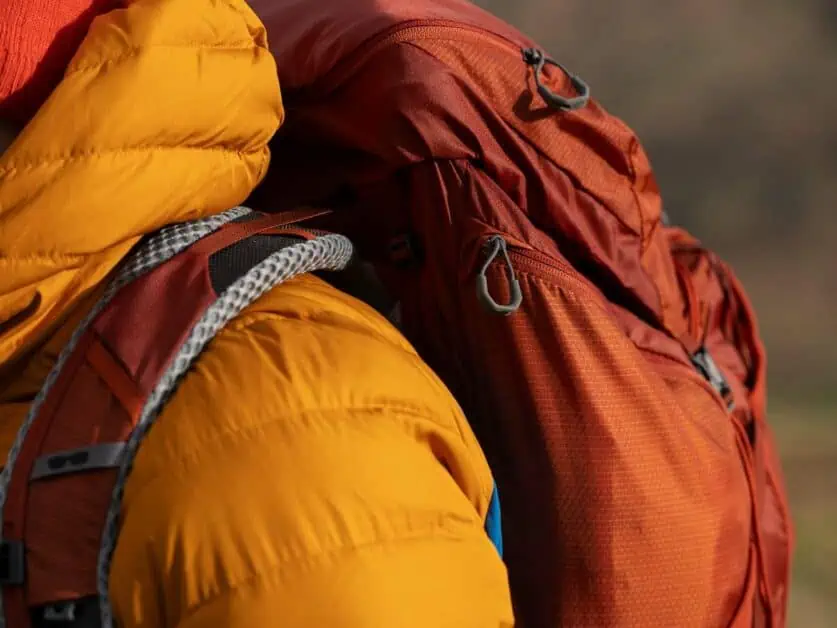
Whether you’re going on a multi-day trip or something much longer, choosing the right waterproof backpack for your needs on a backpacking trip is one of the most important decisions you’ll make with your gear. We tested the best out there to help make your backpacking trips a breeze.
Every backpack on the market is slightly different – some are designed to be ultralight weight, helping you move faster, but also strip away some of the comforts that some hikers might find non negotiables. Others are all bells and whistles and might dwarf you if you have a smaller frame but can be perfect for those who need to carry everything imaginable and more on a trek.
Ultimately, which pack you buy will come down to what you need, what you plan to do and your ideas around comfort and sustainability of wearing the pack.
Editor’s note: This article is part of our buyers guide to waterproof hiking backpacks. See other articles in this series:
- Best Waterproof Hiking Backpacks
- How to Choose The Right Waterproof Backpack For Your Hike
- How We Tested Waterproof Hiking Backpacks
- Compare Waterproof Hiking Backpacks
- Water Resistant vs Waterproof vs Water Repellent – What is the Difference
Looking for other waterproof gear? Check out our buyers guides on:
Table of Contents
ToggleTypes of Backpacks
Thinking about where you plan to use your waterproof backpack for backpacking will help you to determine which is the right model for you. This will also help you to take some of the backpacks available out of the running so you can hone down to your final choice.
Traditional, larger, slower, and not so far: If you’re more interested in taking your time, of if weight isn’t so much of an issue, or you know you need to carry a lot of stuff on the trail, then a more traditional, larger pack may be the best option for you. This is particularly so if you want to carry some extra creature comforts – do you like a nice camp stool in the evening, or want to bring a great campfire and cooking set up you’ve been honing down for years? Do you want to bring along a hefty camera set up additionally to your basic everyday needs? These larger, more traditional types of packs (similar in feel to those used by the army) may suit you perfectly, especially if you don’t plan on hiking as far.
They usually have more substantial frames than lighter weight set ups, with more full-on suspension systems to hold greater capacities easily on the body with comfort. They’re also usually more padded in the back suspension and hip belt areas to carry the load better.
As fast as possible: If you’re someone who wants to leave a larger backpack in the dust and cover as many miles/km a day as possible, then a lighter weight waterproof backpack is likely going to be what you end up going for. Are you more focused on the trail than creature comforts and are happy to shave those off to save precious weight and marginal gains?
Usually, lighter packs are smaller in size, and can also be narrower too. They’re also great for smaller frames. Naturally, they have a smaller load capacity, but usually make use of mesh areas on the front and sides for easy access and differing needs (one day you might store your lunch in the front, whereas the next a warm layer that needs to be stripped off mid ascent).
They’re usually easier to take on and off than larger packs, which allows them to make use of differing systems for storage. You’ll find they have lighter and cutting-edge frames, with what may look like minimal suspension systems in places, but you’ll be pleasantly surprised with their performance if you go for a lightweight pack.
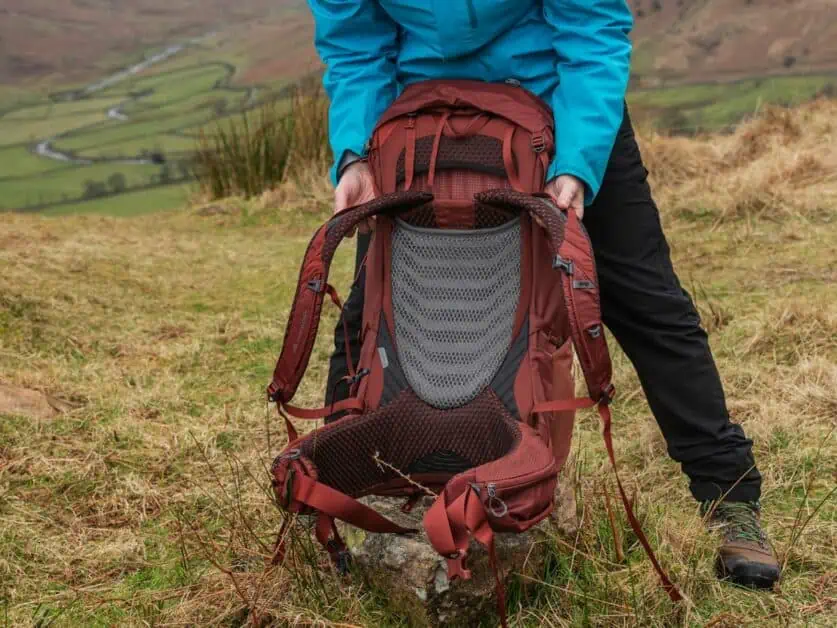
Backpack Materials
You’ll find that most backpacks are made of polyester of nylon. Polyester is a much cheaper option, has a better water resistance level but is also less durable (longer term) than nylon. Nylon is used quite a lot of the time these days. You’ll likely notice denier mentioned quite a lot when it comes to backpack materials – the higher denier number you see, will tell you how thick the material is. This also counts for durability too. A lot of manufacturers are using a combination of both nylon and polyester on waterproof backpacks – making use of polyester’s heavy duty water protection on areas that need it and a lower denier nylon for areas that don’t require so m
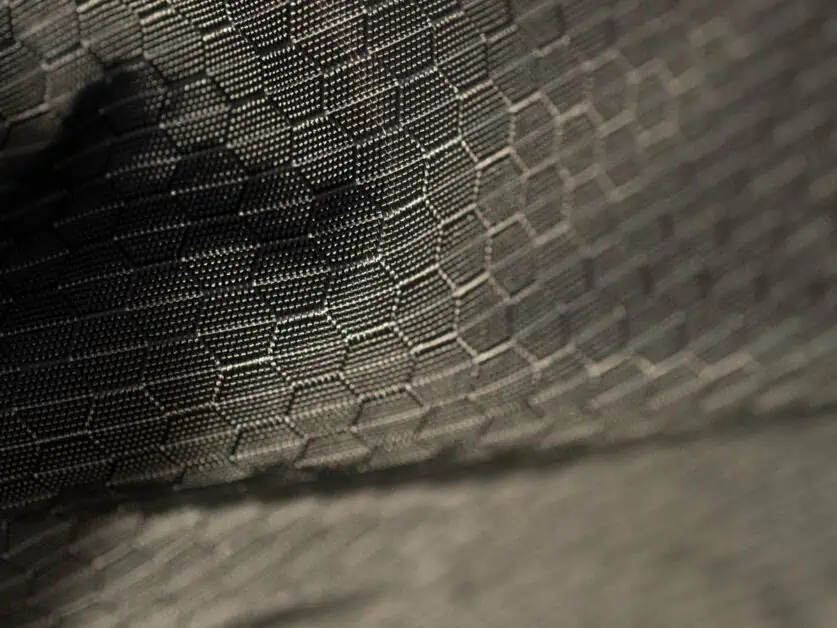
Weather Protection
Unless you know you’re going to be hiking in constant full sun, there is a very strong chance you’ll come up against rain and weather at some point during your hike, so knowing that your backpack has adequate weather protection for your trail is paramount. This is especially important in heavy downpours – as nobody wants to get to camp to find out everything inside their pack is wet through.
Most backpacks on the market now have a DWR (durable water repellent) coating. DWR coatings will vary wildly between packs, with some being better than others, but you cannot rely on this alone if you are going to find yourself potentially hiking in storms of heavy rain.
The most obvious option at this point is to make sure the pack you buy has a rain cover or can use a pack liner. A pack liner isn’t the most elegant solution (you can also make use of something like a bin bag) but does need you to empty the pack to access your stuff – not great on the trail. A rain cover makes a better option – and most packs that specify themselves as a waterproof backpack will have them – if not, they are relatively cheap to buy. Just make sure to measure your pack to ensure your chosen one will fit before buying.
Breathability
Breathability is most important on a waterproof backpack around the back and back suspension, shoulder straps and waist straps. These areas can all become sweaty, especially if the pack is too close to your back. Most backpacks now make use of a suspension system that includes mesh and vents whilst also holding the pack slightly away from the back to allow for air circulation. The same is to be said for shoulder straps and waist belts – which usually make use of breathable membranes and mesh to help keep areas as low sweat (and help avoid chafing) as possible.
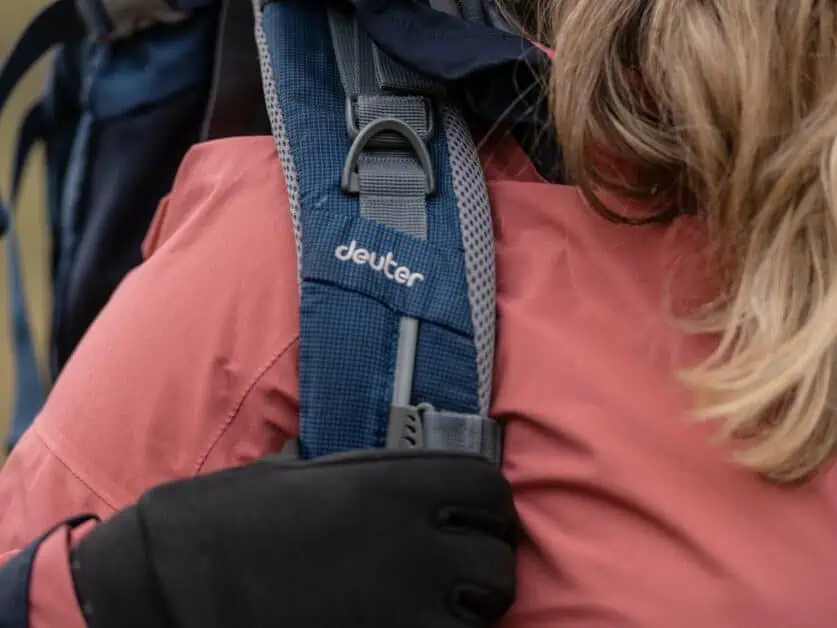
Fit and Adjustability
The great news is that most backpacks have a good degree of adjustability to help with the fact that your body shape is completely different to the next person on the trail. You’ll want to measure your torso length well and use this as the basis for the pack you buy. To do this, you’ll want to measure from the C7 vertebrae (in your neck) to your iliac crest. To find this, bend your head forward slightly – you’re looking for the vertebrae that is at the bottom of your neck and sticks out slightly. If you use a belt, you can put this across the top of your hipbones to give you the line at which to measure to for your iliac crest.
You’ll find that some manufacturers have simpler systems than others for changing the fit and feel of the torso length of your backpack. If you want to change your backpack and adjust it to better fit your needs, always do so with a loaded pack as this will change the fit quite dramatically from an empty one. You will also find that you can adjust the load lifters on the top of the pack which will help you to get the right angle or ‘seating’ as well as stabilizer straps on the hip belt and shoulder straps, which can usually be tightened once the pack is fastened.
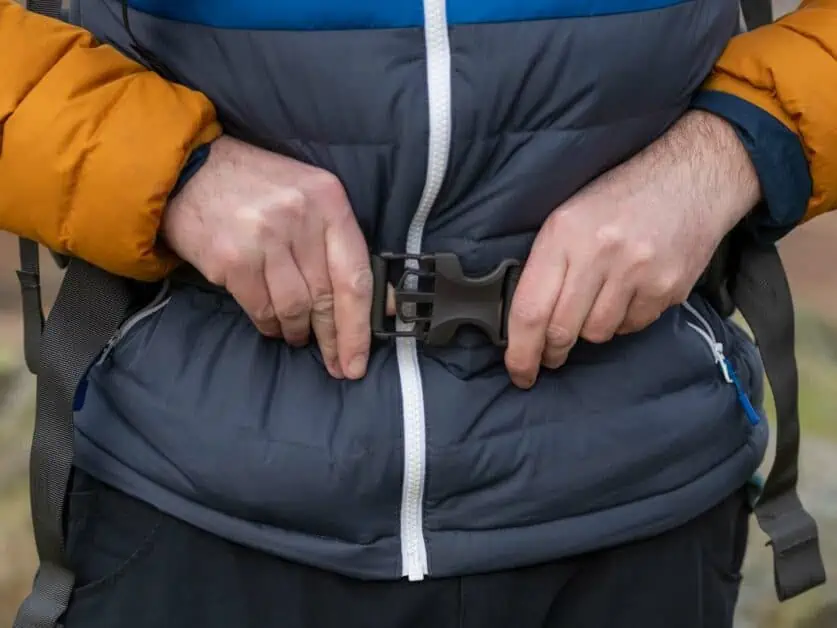
Pack Weight
Some waterproof backpacks for backpacking are heavier than others. As mentioned above, some are designed moreso for ultralight hikers, whereas others are designed to carry a heavier set up where pace and mile coverage isn’t as big a concern. There are also packs that sit in the middle – a kind of hybrid between a heavier pack and a lighter weight. You may find that a much lighter pack will compromise in comfort – after all, you can only really decrease the weight so much by changing materials, most of the lightweight nature comes from reducing padding and extra features. That said, packs that get this balance nicely between weight and comfort are packs such as the Osprey Atmos AG 65, the Osprey Kestrel 48 and the Osprey Aether Plus 70.
Storage Options and Ease of Access
Each backpack has its own storage system that differs from the next, however, there are certain areas that you’ll find the same. Generally, on larger backpacks intended for backpacking, the hip belt will include a pocket. These can be larger or smaller and are great for keeping things like your smartphone or snacks in. They can be harder to open and particularly close if they have a zip and you’re wearing gloves.
Most backpacks include space for a water bladder, and most manufacturers will offer a matched water bladder for your pack. It is always best to purchase the water bladder made by your backpack supplier as this will be properly fitted for the backpack’s needs. This can help avoid any potential problems with leakage. You’ll generally find that water system pouches are separate from the main compartment, helping in case the worst happens.
You can also expect well positioned zips on most backpacks that are designed for backpacking. Whilst it is traditional to have an opening at the top, many manufacturers are also adding long zips across the pack to make it easy to access your gear on the go. There are usually mesh sections for changing needs and these are great for keeping anything that needs to dry in as they offer better ventilation. There’s also usually pockets to store valuables like your keys and wallet. Ultimately, you will find little features and nooks that you can make the most of depending on your needs and gear.
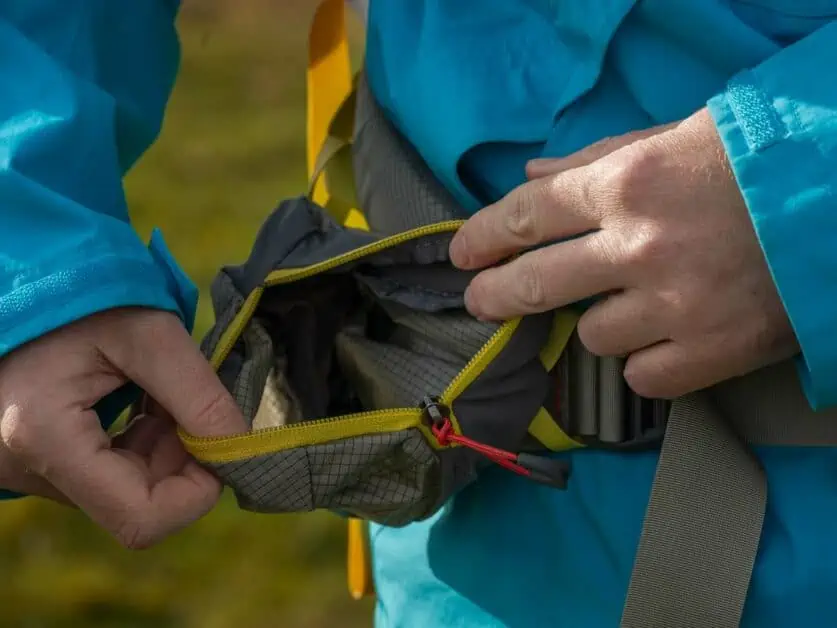
Straps
If you’re looking at a backpacking pack, you’ll likely wonder why there are so many straps that seem to just be there for no reason, but they are there to be useful. Of course, the main straps on your pack are the shoulder straps. These are usually very padded. We believe a very important decision as to which pack you choose should be determined by how much padding you think you need. Generally, more traditional heavier weight packs will have greater cushioning, but some lighter weight options make the best of this too. If you know you’re going to be carrying a big weight for a long time, then well-padded straps will be the best option for you. Otherwise, it can lead to chaffing and sores under the areas where pressure has built up – the same is to be said for hip straps around the belt.
The other straps generally control the tension of the pack top to the body, the suspension system, allow space for crampons, ice axes and hold tension in other areas of the pack to keep it as compressed as possible.
Comfort
Regardless of whether you’re going hiking for a few days or a few months, your comfort is your biggest concern. The padding on your backpack is important and padding does make a backpack heavier. This also makes it easier to carry a load and avoids areas of chafing and rubbing which can turn to sore spots. The level of padding you need will be a personal preference.
The frame and suspension are also important for your comfort levels whilst out on the trail. These can either sit on the outside or interior of the pack and work with a suspension system to allows the weight to transfer properly between your shoulders and hips. All manufacturers have their differences, but they generally work along the same principle.
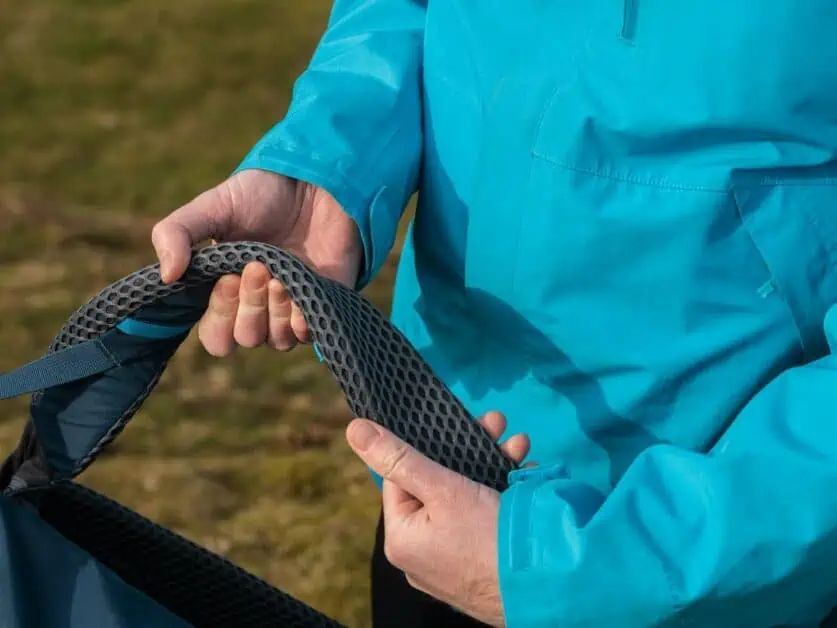
Features
The level of features you want on your waterproof backpack will really depend on what kind of creature comforts you want with you whilst you’re on the trail. There are several features that are fairly common on waterproof backpacks though, these often include compression straps to allow you to stabilize your load and attach other items to the front of your pack. You’ll find loops and webbing straps that can be used for other pieces of kit and attachment points for trekking poles, sunglasses, trash cans and things like ice axes.
Sometimes the lid or top of the backpack can also be removed. This can sometimes be turned into a small day pack – for example on the Osprey Aether Plus 70. This can be very helpful if you’re pitched up for a few days and want to explore from your base camp. You’ll also find things like a handy trash can provided on the Big Agnes Parkview 63.
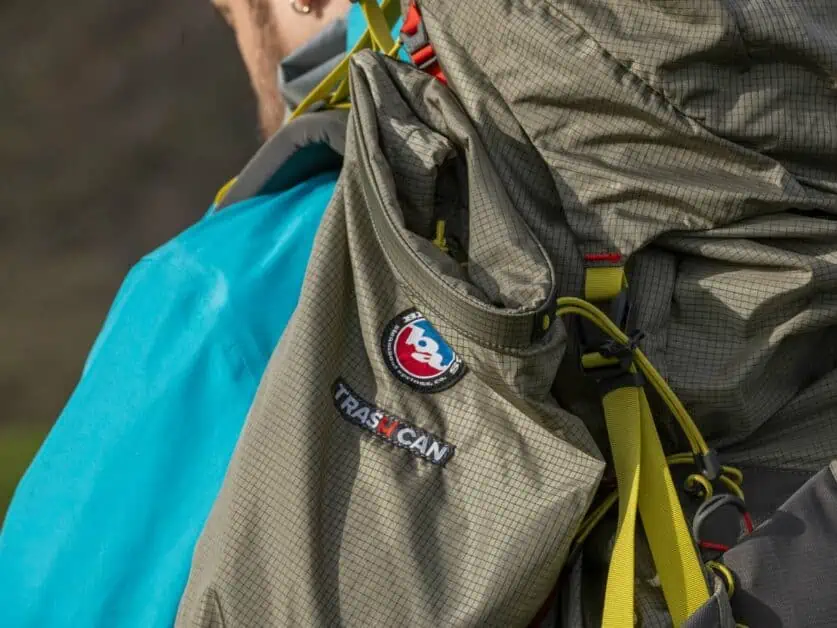
Durability
The durability of your backpacking pack is incredibly important – as they can come up against lots of scuffs and scrapes whilst you’re on the trail. Also, their waterproof nature is incredibly important to consider too. It’s worth checking out the materials, waterproofing and other areas which could be ‘weak’ points to allow you to make the best decision for your needs.
Sustainability
Many backpack manufacturers are making some serious leaps to do their bit for the environment – from sourcing better materials to completely decommissioning processes that were harsh to the environment. You’ll also find recycled fabrics being used a lot and Bluesign approval is often a good indication of the brand’s dedication to production certification through and through. Other than this, sustainability also comes from choosing a pack that is going to last you for a long time and work in as many scenarios as possible, to avoid having to over buy.
Cost
Waterproof backpacks that are intended for backpacking of course have a price attached, and this can vary from higher end to more approachable starter level. Our advice is always to buy the best you can with the budget you have, and you’ll likely get a pack that will last you for years. Kit can cause a major barrier to the outdoors, and thankfully, there are several brands who are producing gear that comes in at a slightly lower price point too. In this regard, we were impressed with The North Face Terra 55 and the Gregory Paragon 58.
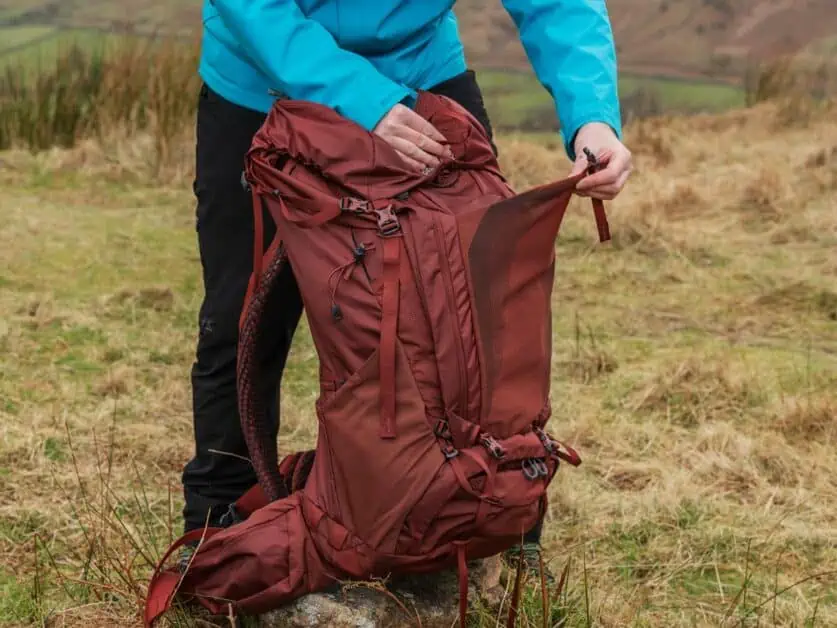
What Are the Different Styles of Backpacks?
It’s vitally important to make sure the backpack you buy for backpacking is right for your needs. If it’s too big, it will feel overwhelming, and you won’t want to carry it – which will impact your enjoyment of the trip. If it’s too small, you’ll have to leave out some of the items you want to bring, only being able to bring the vitally important items and leave the creature comforts at home.
With that in mind, there are various styles and types of backpacks depending on where you plan to use your pack and for how long.
Lightweight
For some hikers, a lightweight pack is the most relevant, and if you’re making use of other ultra-lightweight gear for your backpacking trips, it makes sense to go with this as your option. Generally, a lightweight backpack will make less use of padding, though they are still fit for purpose. They’ll also use lower denier, more mesh and have a lighter suspension system. This style also makes sense if you have a smaller frame and will not be carrying as heavy a load. The capacity you need will really depend on how long you are planning to hike for and your needs.
Weekend Trips
For a weekend long hike or backpacking trip, a pack that holds between thirty and fifty liters will fit the bill. You can decide between a lightweight or a heavier duty pack with more cushioning, especially if you plan on taking the trail slower and spending more time at camp. This will provide more than enough space for you to bring the essentials and some creature comforts without having a pack that is too heavy to enjoy the trail.
Multiday Trips
Generally, you’ll want a fifty-to-seventy-five-liter backpack for a longer trip. This will allow you to make the most of every bit of space for everything you’ll need for more time outdoors. With this kind of pack, you’ll find more padding around the shoulder straps and the hip belt to help with comfort when carrying a heavier load. The pack will also have a more substantial suspension system which helps not only with back and whole-body support but will also reduce the moisture build up you might expect after building up a sweat. With this all in mind, larger packs for longer treks tend to be heavier than the lighter weight packs you can get away with for shorter trips.
If you’re planning a range of different hikes, we’d advise you to get a slightly bigger pack then you think you need so that you can add to your kit and load over time depending on your needs. This also means you have more space for a few creature comforts which will go appreciated on a longer trip.
Women’s Packs
Many of the backpacks we’ve listed are specific for men, however, most of these packs are suitable for women too. Some backpacks do have a slightly different system or fit between genders, but it isn’t that big a deal, and you’ll usually find very little in it. Some smaller packs will be better suited to specific body types and frames, but this isn’t always equal, and you’ll also find men’s packs are generally offered in larger sizes than women’s are too. If this is a need for you, looking at a men’s pack will likely be the best option at present (something we’re trying to actively change in the outdoors industry with brands). It is more about finding what is right for your needs rather than sticking to a specific gender.
We are actively trying to encourage outdoor brands to look beyond this tired measurement and create products that are unisex. That said, you can pretty much find a specific women’s equivalent available for all the backpacks we’ve featured in our roundup, they have a slightly different name, but these can all be found by clicking through the links provided and adding women’s to the search criteria.
Tips for Packing Your Backpack
How you pack your backpack can make the difference between enjoying your trip and not – the way the weight is distributed too can make a huge difference and it can also help if you experience back and lower leg problems. You can also expect that a well packed backpack will make it easier for you to access everything you need as easily as possible when you need it. Below, we’ve outlined the essential ways you can improve the feel of your backpack by what you put in each section.
Main Compartment
This is the area where most of the weight distribution will occur, and with this in mind you want to put most of the heavier items you’re bringing with you at the bottom of your main compartment. Think your tent and a bear can if bringing. Then your sleeping bag should go next your tent. In the middle of the main compartment, your bulkier equipment such as cooking gear make most sense. Then food above this, and waterproof layers at the very top. This allows you to pack in such a way that distributes the weight in the best possible way.
Hip Belt Pockets
Depending on the size of your hip belt pockets, you can use this to keep the items you need, closer to hand. This might include your smartphone, your sunglasses, a small packable waterproof, or snacks. If using a safety device or navigation this can also be a good place to keep that too – or a portable phone charger for example.
The Lid
The lid is a great place to keep personal items like toiletries, changes of clothes, first aid kit and anything you’re likely to need in camp in the evening. If you’re buying a pack with a detachable lid, this can also make it very easy to carry these things into your tent with you when you need them. It’s a good idea, if possible, to keep these items in small packing cubes, which allow easy access without the fear of items dropping out when you open the pack. If you also have a detachable lidded pack, you can also use this to carry your day pack essentials, which is especially helpful if you’re using your camp as a basecamp set up and exploring from day to day.
Stash Pockets
The mesh pockets that you find on your backpack are handy for so many things you might need to carry on your trip. Depending on whether you have a water bladder set up, you can use one of the side pockets to stash your water bottle, or your trekking poles. The other side makes a great space for your fuel canister (depending on your set up). A tip here – if putting your fuel canister on the side, make sure that you cover your pack well when it starts to rain as to not flood the canister and make cooking close to impossible.
The front mesh section can be used to store layers of clothing and wet layers as they will dry out quickly here. You can also use this for trekking poles if you’re struggling for room on the sides. This is also a handy section for keeping a sleeping pad or camping chair if it won’t fit in the main compartment.
Using Straps
The tension straps on the front of your backpack can be used well to help keep the size of your pack compressed to prevent any areas from becoming loose and impacting the weight distribution through your pack. You can normally use the clasps to close these, with the pulls being used to tighten them to the desired level.
If backpacking with someone else, it’s always helpful to put on the full pack and have them adjust the straps to the desired level based on how the pack feels for you and the comfort level you’re getting. If alone, you can tighten these to a level, try the pack back on and then take it off to adjust them some more depending on how the pack feels.
Conclusion
The right backpack will make all the difference to your enjoyment when it comes to your backpacking trip. Pick a pack that is too small, and all the creature comforts you need to keep your morale high will need to be left at home. Pick a backpack that is too big, and you’ll feel that the weight isn’t distributed properly or is too big for your frame and feels too cumbersome to take on and off. As you can see, there is a lot to consider when it comes to buying a waterproof backpack for backpacking. This guide’s aim is to debunk a lot of the information you need to know to make the right decision and we hope you feel clearer on the right waterproof backpack for your time on the trail!
Disclaimer: This article contains Affiliate Links. You won’t pay any more for buying through these links, but we may receive a commission from any purchases made through them. As an Amazon Associate, we earn from qualifying purchases. If you choose to support us by buying through our links, we thank you as it helps us to continue providing the resources we do to help you enjoy the outdoors more!
